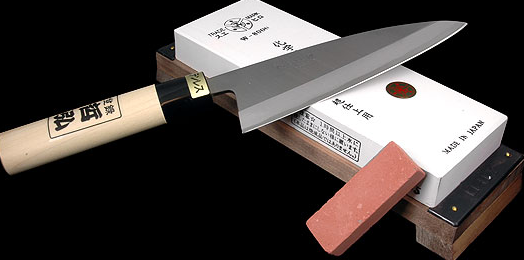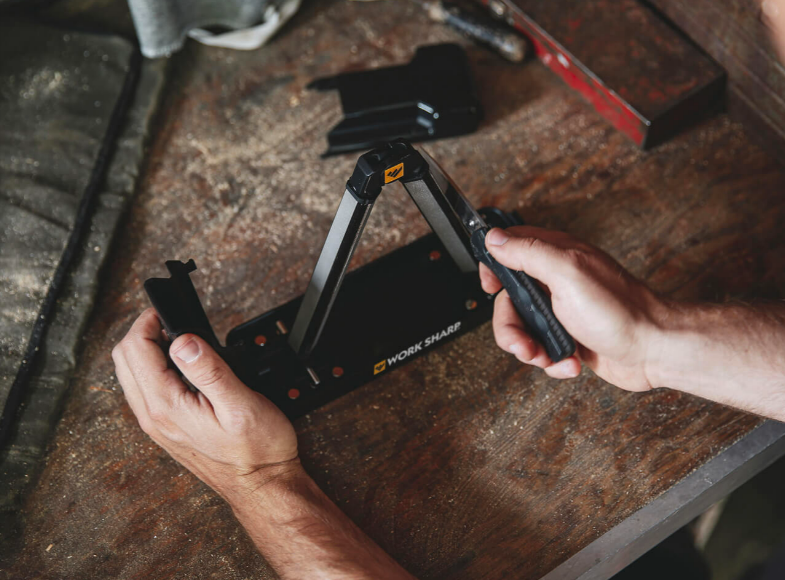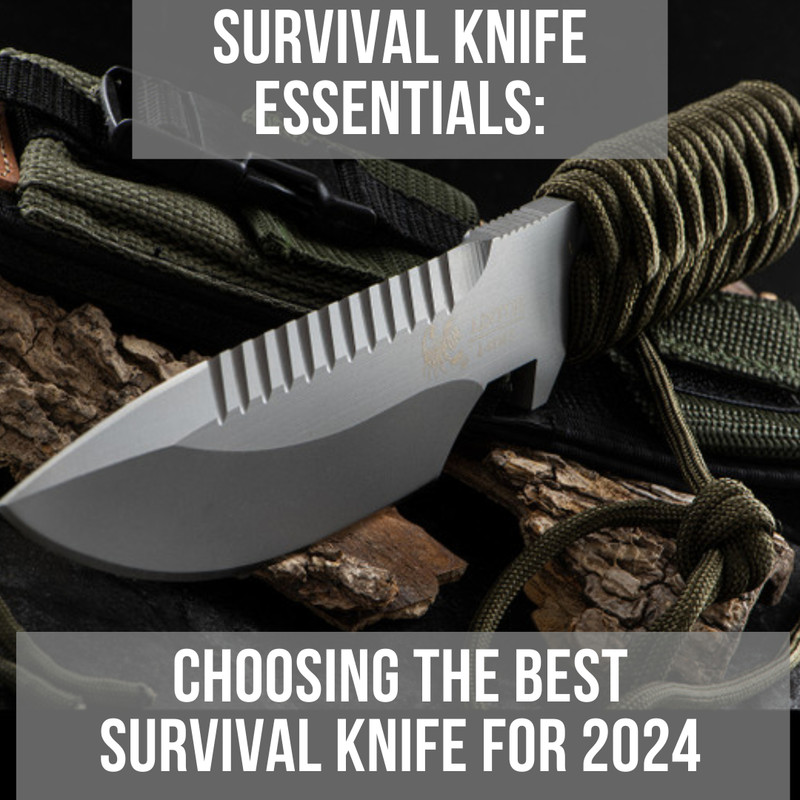Knife Sharpening Essentials: A Guide For Outdoor Enthusiasts
Posted by HH on 3rd Nov 2023
Keeping your knives sharp isn't merely about making tasks more efficient. It’s also about safety because a sharper blade actually reduces the risk of accidents.
In this guide, we'll demystify everything from understanding the science behind sharpness to choosing between manual and electric sharpeners, even touching on professional services in case DIY isn’t quite your thing.
Stick around, because we're about to dive into advanced techniques that guarantee razor-sharp edges every time. It's something any outdoor-knife enthusiast would crave!
Table Of Contents
- The science of knife sharpening
- Knife sharpeners explained
- Proficiency in using whetstones
- The debate between electric vs manual sharpeners
- Advanced knife sharpening techniques
- Troubleshooting common knife sharpening issues
- Safety precautions during knife sharpening
- FAQs in relation to knife sharpening
- What is the best way to sharpen a knife?
- Is it worth getting knives sharpened?
- How can I sharpen my knife at home?
The science of knife sharpening
Knife sharpening, in essence, is an art backed by science. It's all about understanding the physics behind sharpness and applying it to achieve a cutting edge that performs optimally.
The physics behind sharpness
A sharper blade is more efficient and safer to use. But why? The answer lies within the microscopic structure of the blade itself. When you view a dull knife under a microscope, you'll see jagged teeth along what should be its smooth cutting edge.
These 'teeth' can snag on whatever material you're trying to cut through instead of slicing cleanly through it as intended. A well-sharpened knife will have less resistance because these snags or 'burrs' are eliminated during the sharpening process. Recent scientific studies further support this notion by demonstrating how sharper blades require significantly less force for cutting tasks compared with their dull counterparts.
Understanding sharpening techniques
Different methods used in knife sharpening affect your blade's edge differently due to variations in abrasion patterns produced by different techniques such as using whetstones, electric or manual knife sharpeners. Each method offers unique benefits but also presents certain drawbacks which must be taken into account when deciding which one suits your needs best.
In terms of achieving absolute sharpness though, nothing quite matches traditional hand honing using quality stones. By meticulously controlling pressure, angle and motion during the sharpening process, one can sculpt a razor-sharp edge that simply cannot be matched by most electric sharpeners.
However, it's worth bearing in mind that this is not to suggest electric or manual sharpening techniques are inferior. In fact, they're excellent for quick touch-ups or when you need to bring back an edge on heavily used knives in busy environments, where speed is often more critical than achieving the ultimate sharpness.
So, getting to grips with the science of knife sharpening lets us make smarter choices about which method we pick and how we keep our blades in top shape.
Recap:
Knife sharpening is a blend of art and science, with an understanding of the physics behind sharpness key to achieving an efficient cut. Sharper blades require less force, making them safer and more effective. Different sharpening techniques offer unique benefits and drawbacks - traditional hand honing provides unmatched sharpness, while electric or manual options are great for speedy touch-ups.
Knife sharpeners explained
If you're looking to keep your blades in tip-top shape, understanding the variety of knife sharpeners on offer is key. Let's delve into the details.
Types of knife sharpeners
You've got an abundance of possibilities when it comes to selecting how to bring that sharpness back onto your knife. Two major categories are manual and electric sharpeners.
Manual sharpening methods, such as whetstones or honing rods, require more skill but give control over every stroke. They range from pocket-sized gadgets for quick touch-ups on-the-go to larger bench stones suitable for serious blade maintenance at home.
Moving onto their powered counterparts, electric knife sharpeners do most of the work for you with motorised wheels spinning against your blade at high speed - perfect if you want sharp knives without breaking a sweat. The only snag? You'll need an electrical outlet handy whenever your cutting edges need attention.
Features to consider when choosing a sharpener
Beyond deciding between elbow grease or electricity, there are other features worth considering when selecting a sharpener: material type and grit size being two crucial ones.
The term 'grit' pertains to the size of particles found in abrasive materials used by various sharpeners, including whetstones. Lower numbers indicate coarse grits ideal for setting new bevels or removing small nicks, while higher values denote finer particles best suited for polishing existing edges until they shine like mirror-finish gothic arches.
Different materials also play their part. Some users swear by natural Arkansas stones due to their unique ability to remove steel slowly yet consistently whereas others prefer diamond-coated sharpeners for their ability to quickly re-edge even the hardest of knife steels.
Whether you're a home cook or a bushcrafter, Heinnie Haynes has a vast range of sharpeners to keep your blades razor-sharp.
Recap:
Understanding the variety of knife sharpeners is key to keeping your blades sharp. Manual methods like whetstones offer control but need skill, while electric ones make it easy but require a power source. When choosing, consider grit size for setting bevels or polishing edges and material type for different sharpening speeds.
Proficiency in using whetstones
Achieving the razor-sharp edge that every knife enthusiast desires begins with mastering the use of a whetstone. This is not just about grinding your blade against a stone; it's an art that requires understanding, patience and skill.
Angle guides for whetstone sharpening
The first thing to grasp when using a whetstone for knife sharpening is how to maintain the correct angle. It's alluring to lay your blade on the whetstone and start rubbing it back and forth, yet this strategy won't create great outcomes. The secret lies in holding your knife at a specific angle relative to the whetstone surface.
In most cases, maintaining an angle between 15-20 degrees works best. This can be tricky initially, which is why we recommend using proper angle guides for knife sharpening. These handy tools ensure you're consistently honing at just the right tilt, taking guesswork out of the equation while helping preserve precious blade material.
If you find yourself struggling with keeping steady angles during sharpening sessions or are unsure about what exact incline suits your knives best – don’t fret. You’re far from alone in this boat.
Feel free to contact us for expert guidance in choosing the right sharpness grades and detailed instructions on how to use them effectively. Our years of experience in the knife industry ensures you'll get the best advice.
Grit selection: a critical decision
In addition to maintaining consistent angles while sharpening, another critical aspect of gaining proficiency in sharpening involves selecting the right abrasive grits found in sharpening stones. To achieve a finely honed edge on your blade, it's essential to choose the appropriate abrasive grits, typically falling in the range of 4000 to 8000. This selection is key to achieving a well-maintained tool with a pristine finish.
Recap:
Mastering the art of whetstone knife sharpening involves more than just grinding your blade. It's about understanding how to maintain the right angle, typically between 15-20 degrees, and using angle guides can help with this. Choosing the correct abrasive grit is also key for achieving that desired razor-sharp edge.
The debate between electric vs manual sharpeners
Knife sharpening, while seemingly a simple task, actually involves an intricate process. Two main tools dominate the field: electric knife sharpeners and manual methods like whetstones or honing rods.
The appeal of electric knife sharpeners
Electric knife sharpeners are touted for their convenience and speed. With these devices, you simply slide your blade through designated slots - a swift process that requires minimal effort.
In terms of safety – remember, sharp knives are safer than blunt ones as they're less likely to slip – electric models often have built-in guides which help maintain the correct angle during the entire process.
The case for manual methods
On the other hand, many prefer manual methods such as using a whetstone or honing rod due to their versatility and control over each step in the sharpening process. Similar to preparing food from scratch rather than ordering take-out; it might require more work but offers greater satisfaction knowing you've mastered every detail yourself.
A key benefit here is adaptability - with practice comes precision enabling one to adjust according to specific blade lengths or shapes (think serrated knives). This isn't always possible with electric counterparts designed around generic parameters.
Durability and maintenance considerations
Beyond usage lies maintenance considerations too. When it comes to longevity, well-cared-for whetstones can last decades while electrical components may need replacement sooner.
You wouldn't drive your car without regular oil changes would you? The same applies here where proper knife care involves regular maintenance especially after prolonged cutting tasks.
Comparing results
The ultimate measure of a sharpener's worth lies in the quality of its output. It’s not about the journey but rather, reaching your destination - a sharper edge.
If you desire a more precise sharpening process, manual techniques are the ideal option, offering you the ability to exercise precise control over both grit sizes and sharpening angles.
Advanced knife sharpening techniques
Achieving a razor-sharp edge on your blade involves more than just a basic pass through a knife sharpener. It's an art form, one that requires understanding the principles of honing and sharpening.
Honing vs sharpening
To start with, let's clarify two commonly misunderstood terms: 'sharpening' and 'honing'. Although often used interchangeably, they have different meanings in the context of knife care.
Sharpening refers to the process where metal is removed from the blade using abrasive materials like grit stones or electric sharpeners. This creates a new cutting edge when your blade becomes dull or damaged. Honing, however, does not remove any material but realigns it along the cutting edge. The ideal tool for this task? A honing steel.
You might wonder why we would employ both techniques when they appear to produce similar outcomes, specifically the creation of sharper knives.
- The answer is in their frequency of use and purpose: while you only need to sharpen your blades occasionally (when they become notably blunt), you should hone them frequently (ideally every time before usage) to maintain their optimum performance.
- If done properly, these processes work hand-in-hand because regular honings reduce how often you'll need full-blown sharpenings thereby prolonging the lifespan of your favourite tools.
Troubleshooting common knife sharpening issues
Whether you're a seasoned professional or an amateur enthusiast, encountering issues during the knife sharpening process is not uncommon. Don't despair. Here are some useful tips to help you address these issues.
Dealing with edge nicks
Nicks on your blade's edge can be quite troublesome when trying to achieve that razor-sharp finish. However, by understanding how they occur and using the right techniques, such small damages can be effectively fixed.
Edge nicks are usually caused by accidental contact with hard surfaces or improper use of the knife. They disrupt the uniformity of your cutting edge making it less efficient in performing its tasks. Quality knife sharpeners available at Heinnie Haynes can offer significant help here.
To remove small nicks from your blade edge without damaging it further requires patience and precision. Begin by assessing the extent of damage: smaller nicks may simply require regular sharpening while larger ones might need more targeted treatment using specific tools.
The key to fixing edge nicks is in grinding down both sides of your blade evenly until reaching a level below the nicked area thus eliminating any imperfections on its surface. Remember though, this process will reduce total blade length slightly but will ultimately restore functionality back into your tool.
Maintaining consistent angle guides
Another common issue faced during knife sharpening involves maintaining consistent angle guides throughout every stroke against your sharpener - whether it be a whetstone or an electric knife sharpener.
The angle at which you sharpen your blade significantly impacts its performance. For instance, a smaller degree angle will result in a sharper edge but with reduced durability while larger angles are more robust but not as sharp.
Maintain a steady approach while sharpening your blade. Imagine the right angle before you start and hold that image in your mind as you work. If visualising isn't for you, no worries. Tools like the Angle Set Knife Sharpener or the Spyderco Galley-V can help by ensuring a steady degree of sharpening every time.
Safety precautions during knife sharpening
Handling sharp blades requires meticulous care. Even when dealing with the art of knife sharpening, one must observe certain safety precautions to avoid potential injuries.
Knife sharpening do's and don'ts
A crucial part of ensuring your safety during knife sharpening involves understanding the dos and don’ts in handling both the blade and your chosen knife sharpener.
The first golden rule is to never rush the process. Haste not only compromises the quality of your edge but also increases the risk of mishaps.
You should always secure your knives before you start sharpening them. This can be done by using a vice or clamping device to hold it steady, leaving both hands free to work on honing that perfect edge.
If you're working with an electric sharpener, make sure that it’s switched off before inserting or removing a blade from its slot. Unexpected starts could lead to accidental cuts.
- In case there are any children around while you’re doing this task, ensure they are at a safe distance away from all tools used for knife care.
- Never use damaged equipment - inspect stones and wheels carefully for cracks prior to carrying out any sharpening tasks.
- Last but certainly not least – remember gloves. Wearing cut-resistant gloves can provide additional protection against accidental slips during manual hand-sharpening processes like whetstone setup sessions.
While these tips may seem basic, effective steps such as these go a long way toward keeping yourself injury-free while getting the job done properly.
It is just as crucial to comprehend what should not be done when honing blades, as it is to understand what ought to be completed.
Avoid using a dull blade for knife sharpening service. A blunt tool can require more force to cut, increasing the chance of slippage and subsequent injury.
Never try to catch a falling knife. Let gravity take its course, then pick it up safely.
FAQs in relation to knife sharpening
What is the best way to sharpen a knife?
The top technique for sharpening knives depends on your tool. However, using a whetstone with the correct angle and grit typically gives excellent results.
Is it worth getting knives sharpened?
Absolutely. Sharpening not only improves cutting efficiency but also extends your blade's lifespan. Plus, sharper blades are safer because they reduce slipping risk during use.
How can I sharpen my knife at home?
You can easily hone blades at home using tools like whetstones or manual/electric sharpeners. Just make sure you're maintaining the right angle and pressure throughout.
Well, there you have it - the ins and outs of knife sharpening. From understanding the science behind a sharp edge to choosing between manual or electric sharpeners.
We've covered how to use whetstones, and advanced techniques for that razor-sharp finish. Remember: angle guides are your friends!
Don't forget about professional services if DIY isn’t quite up your street. And once you've got those blades in tip-top shape, proper storage is key to maintaining their cutting prowess.
Above all else, always keep safety at the forefront when handling any knife-related tasks.
Maximise The Performance Of Your Blade With Our Knife Sharpeners









